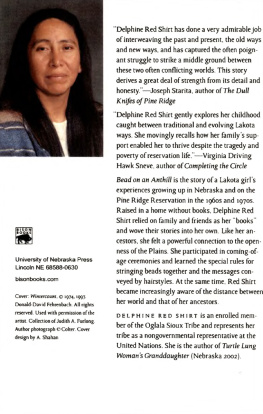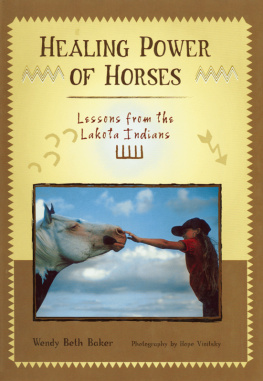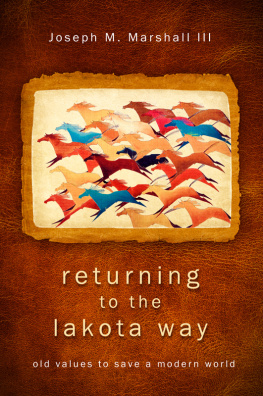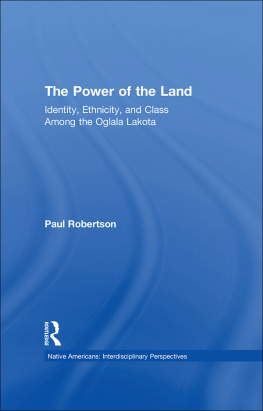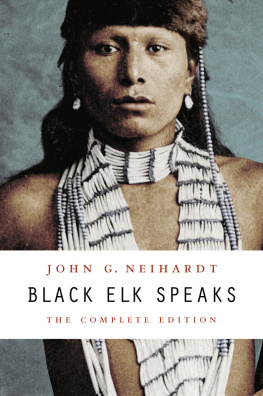

1998 by the
University of Nebraska Press
All rights reserved
Library of Congress Cataloging
in-Publication Data
Red Shirt, Delphine, 1957
Bead on an anthill:
a Lakota childhood /
Delphine Red Shirt.
p. cm.
ISBN 0-8032-3908-4
(cloth: alk. paper)
ISBN 0-8032-8976-6
(paper: alk. paper)
ISBN-13: 978-0-8032-7700-7 (electronic: e-pub)
ISBN-13: 978-0-8032-7701-4 (electronic: mobi)
1. Red Shirt, Delphine, 1957
Childhood and youth.
2. Teton IndiansBiography.
I. Title.
E99.T34R337 1998
973.0497520092dc21
[B]
97-14418 CIP
The publisher does not have any control over and does not assume any responsibility for author or third-party websites or their content .
This book is dedicated to Richard,
to our walkyea
Justin, Megan, and Kirsten,
and to Wy Isnala, Ina mitawa k he e,
nah, Pte Oyate, hena k iyu ha .
A man from the north gave me a cane
I told this girl so.
She will live to be old
Her tribe will live.
[A song from the Tatka olow pi, a ceremony
performed for a young girl when she reaches womanhood.]
Acknowledgments
I am grateful to Richard Harding Shaw, my husband of twenty years, for his astute observations, his comments, and his undaunted belief in me.
I am deeply indebted to Howard R. Lamar, Sterling Professor of History and former president of Yale University, for his interest and support.
I am grateful for the material collected by James R. Walker and made available through the Colorado Historical Society. I am grateful for the Lakota voice of George [Long Knife] Sword, which is present in the material collected by Walker. I am grateful for the documents retained by the Colorado Historical Society that are written in the Lakota language, the language of my true self.
I am grateful for the Lakota-English Dictionary: A Dictionary-oie wowapi wan of Teton Sioux , which was compiled by Eugene Buechel SJ .
I wish to thank Charlotte G. Currier, for being first a teacher and second, a critic. In addition, I would like to thank Barbara MacEachern, Wesleyan University, for her guidance in the beginning.
I would like to thank the following people for reading the manuscript and offering constructive comments: Joe Starita, Allen Trachtenberg, and Richard Kislik.
Introduction
I wrote these stories primarily for the joy of remembering what was good in my life. I wanted to remember these things, to write them down, the old Lakota words and my connection to the world around me through them. These stories are told through the eyes of my childhood but from an adult perspective. They are what I remember; Weksuye meaning I remember; Ciksuye meaning I remember you; Miksuye meaning remember me.
In the process of writing these stories, I felt great satisfaction in reconnecting to my native language, Lakota. I felt at home using it and I felt gratified speaking it again. It came alive for me and brought back all the feelings I felt as a child when I first heard those words spoken. When I began to write using Lakota, I was not sure how its use would come across to the reader. How effective it would be to use my native language to capture the essence of what my culture means to me and of what I wanted to convey about it to the reader. I know now that my writing was richer for its use.
It is a custom in my tribe to begin any public speech or presentation with an autobiographical statement, giving my status in the tribe and telling why I am qualified to speak. In keeping with this tradition, I will only say that there was nothing special about my life except for the fact that I was a Lakota wakyea, a child, born to a strong Lakota mother and gentle father, the two people who gave me my identity. I am grateful to them and to my Lakota ancestors for the right to say in Lakota, Le mye, meaning this is who I am.
Beads on an Anthill
I remember how I once followed an ant home. When I was a child, I was able to do things that seem preposterous to me now. But as a small child, I stayed close to the ground and imagined all sorts of possibilities. I followed the ant home because I needed glass beads to make a ring, a simple string of beads to decorate my finger after the metal washer I had put on it had caused the finger to swell. My father had to take me to the appliance store on Main Street. The appliance service man, who also sold stoves, refrigerators, and washers, used a small clipper to snip it off my swollen finger, the finger I had wanted to adorn with something pretty and shiny. I was determined to find or make a ring, one that would not make my finger swell. So I decided to make one out of brightly colored beads.
It was common knowledge among the children in my neighborhood, and some of the adults as well, that the ants collected our discarded beads and carried them home. So, I followed an ant home. In Nebraska the roads are hard-packed, and the dirt is an off-white color. I followed the ant up the hill past my great-aunts house and to the trail behind her house where the road ended and tall weeds grew in clumps. It was easy for the ant to make its way through what must have seemed to it a forest of tall trees. I followed it past clumps of dirt, a few discarded potato chip bags, and broken glass to the ant pile it called its home. There the other ants milled about on a mound that rose about four or five inches from the ground. The mound had one hole in the center, and around this opening, scattered about like planned landscaping, were small round rocks and beads. Beads of all colors. I remember the blue, pale green, yellow, red, and even the white beads that were scattered about the opening, childlike decorations or offerings to a god. I watched the ant enter the pile, and then I lost track of it. It had led me to what I wanted, and I forgot it immediately.
I patiently watched the ants entering and exiting the mound in a rhythmic way. I could have sat on my haunches or heels on that hot summers day and watched the ants forever. Instead I carefully picked out the beads I wanted for my ring. I worked carefully and slowly, watching the ants run from the pincers my small fingers formed, in order to fish out the best beads. I didnt want to disturb them. I was as afraid of them as they were of me. I was afraid particularly of the red ants, afraid of their pincers and the way they attach themselves to you securely before stinging you.
I selected the best beads, the unbroken ones. I often wonder how they carried those beads up the hill from our neighborhood to their mound. Did they take turns carrying them, or did they just pick them up securely and walk for days to reach their pile? How persistent they were in stealing the beads from us, as persistent as we were in stealing them back. That day I raided the anthill, I took all their blue and yellow beads. I walked away without a twinge of guilt, the beads in my hand, ready to find a needle and thread. I dont remember being cruel by messing up their pile with my foot or a stick. I only remember taking what I wanted and waiting for another day to find the colors I wanted that they didnt have that day.
I carefully carried the beads home in my small hand. I saw my aunt sitting underneath a tall cottonwood tree. She held a small bowl in her lap. An inch or so of multicolored beads covered the bottom of the bowl. She did what others in our neighborhood did: she waku, or beaded. The Lakota word for bead is pito. The word for beading is ku, which sounds like K-show. My aunt beaded well. She worked on a loom, a small wooden frame about a foot long, with a width of six inches. It resembled a stringed instrument, something like a violin only strung with nylon thread. The player is the beader who picks out the beads on her needle in a combination that will add to the design that is already on the loom, or she may begin a new pattern. She moves across the strings as if to play the violin strings with a bow, places the beads between the threads, and returns back through to secure them. The wooden frame my aunt worked on so patiently held a white beaded band with bold geometric designs on it. She created her own design the way a composer writes music or an artist paints a picture. She worked methodically and looked carefully to fish out the right combination of beads from the bowl, the same way I fished out the beads from the anthill. I preferred the beads that were the color blue, to, we say in Lakota.
Next page
